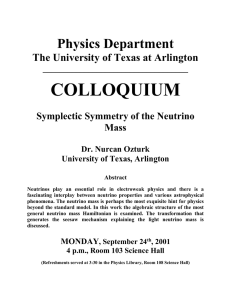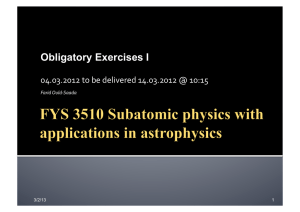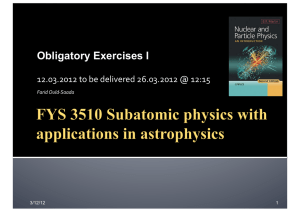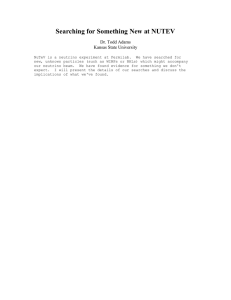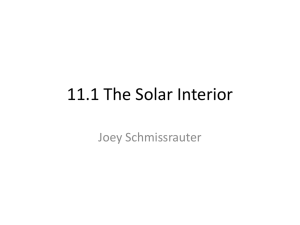INSS 2016 Tutorial Problems
advertisement
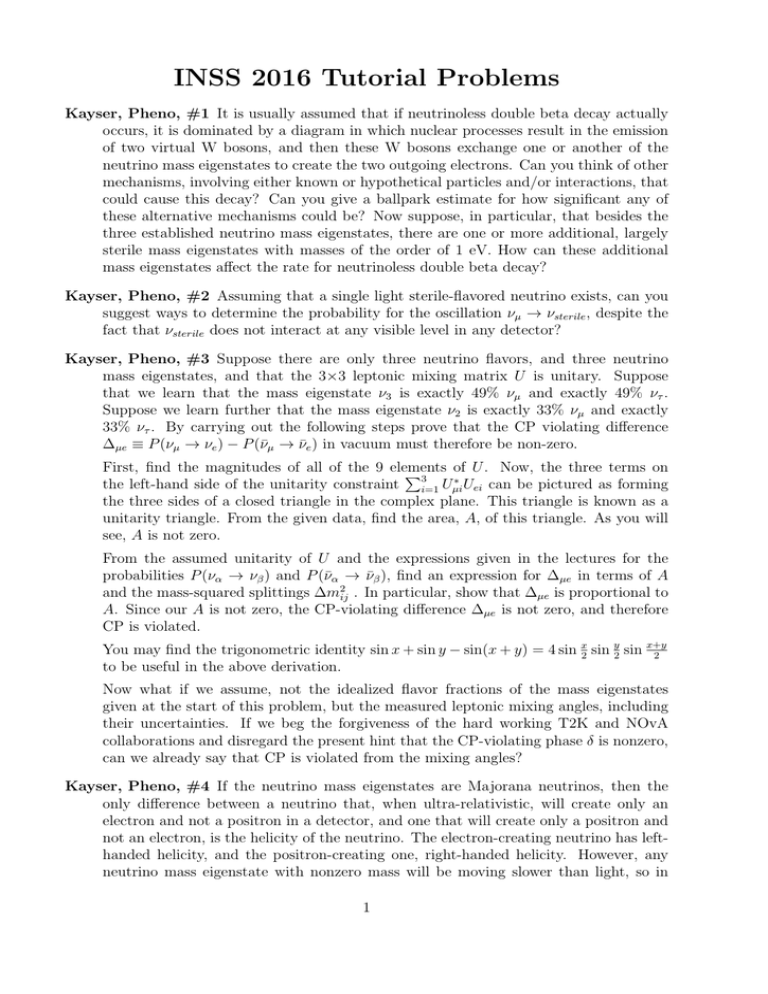
INSS 2016 Tutorial Problems Kayser, Pheno, #1 It is usually assumed that if neutrinoless double beta decay actually occurs, it is dominated by a diagram in which nuclear processes result in the emission of two virtual W bosons, and then these W bosons exchange one or another of the neutrino mass eigenstates to create the two outgoing electrons. Can you think of other mechanisms, involving either known or hypothetical particles and/or interactions, that could cause this decay? Can you give a ballpark estimate for how significant any of these alternative mechanisms could be? Now suppose, in particular, that besides the three established neutrino mass eigenstates, there are one or more additional, largely sterile mass eigenstates with masses of the order of 1 eV. How can these additional mass eigenstates affect the rate for neutrinoless double beta decay? Kayser, Pheno, #2 Assuming that a single light sterile-flavored neutrino exists, can you suggest ways to determine the probability for the oscillation νµ → νsterile , despite the fact that νsterile does not interact at any visible level in any detector? Kayser, Pheno, #3 Suppose there are only three neutrino flavors, and three neutrino mass eigenstates, and that the 3×3 leptonic mixing matrix U is unitary. Suppose that we learn that the mass eigenstate ν3 is exactly 49% νµ and exactly 49% ντ . Suppose we learn further that the mass eigenstate ν2 is exactly 33% νµ and exactly 33% ντ . By carrying out the following steps prove that the CP violating difference ∆µe ≡ P (νµ → νe ) − P (ν̄µ → ν̄e ) in vacuum must therefore be non-zero. First, find the magnitudes of all of the 9 elements of U . Now, the three terms on P3 ∗ Uei can be pictured as forming the left-hand side of the unitarity constraint i=1 Uµi the three sides of a closed triangle in the complex plane. This triangle is known as a unitarity triangle. From the given data, find the area, A, of this triangle. As you will see, A is not zero. From the assumed unitarity of U and the expressions given in the lectures for the probabilities P (να → νβ ) and P (ν̄α → ν̄β ), find an expression for ∆µe in terms of A and the mass-squared splittings ∆m2ij . In particular, show that ∆µe is proportional to A. Since our A is not zero, the CP-violating difference ∆µe is not zero, and therefore CP is violated. You may find the trigonometric identity sin x + sin y − sin(x + y) = 4 sin x2 sin y2 sin x+y 2 to be useful in the above derivation. Now what if we assume, not the idealized flavor fractions of the mass eigenstates given at the start of this problem, but the measured leptonic mixing angles, including their uncertainties. If we beg the forgiveness of the hard working T2K and NOvA collaborations and disregard the present hint that the CP-violating phase δ is nonzero, can we already say that CP is violated from the mixing angles? Kayser, Pheno, #4 If the neutrino mass eigenstates are Majorana neutrinos, then the only difference between a neutrino that, when ultra-relativistic, will create only an electron and not a positron in a detector, and one that will create only a positron and not an electron, is the helicity of the neutrino. The electron-creating neutrino has lefthanded helicity, and the positron-creating one, right-handed helicity. However, any neutrino mass eigenstate with nonzero mass will be moving slower than light, so in 1 principle we can move faster than this neutrino. In our rest frame, the helicity of the neutrino will be opposite to what it is in the frame originally discussed. Nevertheless, common sense tells us that the charge of the charged lepton that this neutrino creates is of the same sign in all frames. Explain how this can be so. Xing, Mass models, #1 Why there is usually a factor 1/2 in the Majorana neutrino mass term? Xing, Mass models, #2 The inverse seesaw mechanism is an extension of the standard model with three heavy right-handed neutrinos, three gauge-singlet neutrinos and one Higgs singlet. Please try to derive the effective light neutrino mass matrix and understand why this mechanism is more natural to obtain tiny neutrino masses and appreciable collider signatures. Xing, Mass models, #3 In the presence of three sterile neutrinos (either light or heavy), the full 6×6 active-sterile neutrino mixing matrix can be parametrized in terms of 15 rotation angles and 15 phase angles. Please come up with an explicit parametrization in a way similar to the standard parametrization of the 3×3 PMNS matrix, and then explain why the latter may involve slight unitarity violation algebraically and geometrically. Yokoyama, Detection, #1 Neutrino detectors tend to become larger and larger, given the need for more statistics. Suppose you can turn the whole Earth into a neutrino detector. What kind of science will you be able to probe with such a detector? You may assume the density profile inside the Earth as it is, or instead you can assume that the Earth’s interior is filled with some material at a constant density (e.g. scintillator, water, liquid Ar, ..). Consider various neutrino sources (hence energy range and flavor) and discuss capabilities as quantitatively as possible. Yokoyama, Detection, #2 How have accelerator-based neutrino experiments evolved since the two-neutrino experiment? In the experiment performed in 1962, Lederman, Schwartz, and Steinberger did not find electron production from a muon neutrino beam. Half a century later, long baseline experiments (T2K, NOvA) found evidence for electron production in the interactions of beams that were originally muon neutrino beams. Compare experiments in 1962 and now: including the accelerator, neutrino beam production, neutrino detectors, neutrino interaction models, data analysis and systematic uncertainties. What kind of setup would you propose if you were going to perform the two-neutrino experiment (or, any of other accelerator neutrino experiments in the past) with current technology? Reno Cosm&Astro, #1 High energy astrophysical neutrinos are produced in sources in pγ and pp interactions. Neutrino oscillations over astrophysical distances change flavor ratios from the production sites to Earth. What kinds of source diagnostics can you do based on flavor ratios at Earth? Reno Cosm&Astro, #2 In the standard cosmology with light neutrinos, the number density of neutrinos is determined by the temperature at which the neutrino annihilation rate falls below the Hubble expansion rate (the freezeout temperature). The relic neutrino number density is just a rescaling of this number density accounting for the 2 expansion rate of the Universe. The Hubble expansion rate in this radiation dominated era at freeze-out depends on the effective number of massless degrees of freedom g∗ , !4 !4 X Ti 7 X Ti g∗ (T ) = gi + gi . T 8 T bosons f ermions For example gγ = 2. The equality of the interaction rate Γ = nσ|v| ∼ G2F T 5 and the 1/2 expansion rate H ' 1.66g∗ T 2 /mpl occurs at about T ∼ 1 MeV. Does it matter whether or not neutrinos are Majorana or Dirac if they are light? If instead they are non-standard model heavy neutrinos, how do you think the Majorana or Dirac feature will affect cosmological abundances of a heavy neutrino? What about a light (say keV) sterile neutrino that has mixings with, say, electron neutrinos. What are some of the considerations in determining the relic abundance of sterile neutrinos? What are potential astrophysical constraints on sterile neutrinos? There is an extensive literature on the cosmology of sterile neutrinos that mix with active neutrinos. There are two white papers (arXiv:1204.5379 and for keV sterile neutrino dark matter, arXiv:1602. 04816) that you could use as references to get a more quantitative handle on how sterile neutrinos can be constrained. Raaf, Atm&Solar, #1 Atmospheric neutrinos (and antineutrinos) come in a huge range of energies (E) and baselines (L), covering 5 orders of magnitude in energy, with baselines from ∼10km–∼13000km. They can be used to study many things, including zenith angle dependence of oscillation, oscillation pattern as a function of L/E, tau neutrino appearance, neutrino mass hierarchy, etc. What other properties of neutrinos might we be able to study using atmospheric neutrinos? If you can use existing experiments, how would you undertake your study? If you need a new experiment, design it and explain what features are improved over existing experiments, and explain how you would undertake your study. Raaf, Atm&Solar, #2 The solar neutrino oscillation probability vs energy has a transition region where the probability moves from being dominated by vacuum oscillations to being ruled by matter (MSW) effects. Borexino’s low energy measurements of solar neutrino oscillations prove there must be an upturn in the oscillation spectrum as a function of neutrino energy. Super-K has the best constraints in transition region, but no measurement of the actual upturn yet. Design a new experiment (or improve an existing one) to map out the spectral upturn, thereby confirming the MSW effect and resolving the tension between KamLAND’s measured δm2 and the δm2 preferred by solar neutrino experiments. McFarland, Interactions, #1 For the NuMI off-axis beam used by NOvA, estimate the relative rate of quasi-elastic νe− events compared to νµ + e → νµ + e events. (You may either look up detailed fluxes for the NuMI beam or use the following assumptions: peak neutrino energy of 2 GeV with a ”narrow” spectrum, total νµ to νe ratio of 60:1, average νe energy 3 GeV with a broad energy distribution between 1 and 5 GeV). Devise all the strategies you can think of to allow the NOvA detector to distinguish between these two classes of events, and evaluate which approaches you think are the most promising. Make your analysis as quantitative as possible, even if you have to guess at some numbers such as the performance of the NOvA near detector. 3 McFarland, Interactions, #2 Postulate a neutrino detector that tells you the angle of final state muons and nucleons, but nothing about their energies. For a quasi-elastic reaction on a free nucleon, calculate the neutrino energy from only the angles of the muon and nucleon with respect to the neutrino beam. Show how p this relation is modified if the initial nucleon has momentum vector p and total energy p2 + M 2 −EB in the lab frame. (In an overly simple model of the effect of the nucleus, p would represent motion inside the nucleus and EB a binding energy required to bring the final state nucleon on-shell when it is removed from the nucleus.) For a uniform p~ in three space with |p| < pmax , for a fixed EB , and for neutrinos of 600 MeV, 2 GeV and 5 GeV energies, calculate and plot the distribution of differences between the true neutrino energy and the energy reconstructed if you assume p = 0. Do this for different pmax . What happens if you alter the distribution of p to include some sort of long tail of high momentum events? (The last is a crude way to include the effect of correlated nucleons.) McFarland, Interactions, #3 In electron anti-neutrino electron elastic scattering (ν̄e + e→ ν̄e + e− ) and in inverse beta decay ( ν̄e + pn + e+ ), what can you infer about the neutrino energy from measurements of the outgoing electron or positron in a scintillator detector? (For monitoring of nuclear reactors using neutrinos, it is important to know the spectrum of the emitted neutrinos to determine the core composition.) Discuss the practicalities of making such measurements for each of these two reactions. Without worrying about practical considerations (e.g., cost and siting), design a detector to use either or both of these reactions to precisely measure neutrino energies from a reactor. See also problem Seo, Reactor, #2. McFarland, Interactions, #4 Neutrino energy must be reconstructed in accelerator neutrino oscillation experiments in order to infer neutrino oscillation parameters. For one or more current or proposed massive long-baseline detectors (water Cerenkov, scintillator and liquid Argon TPC), develop strategies to measure neutrino energies from 500 MeV to 5 GeV based on detection of final state particles. (Different strategies will likely be necessary at different energies.) Make realistic assumptions or guesses about particle detection thresholds and resolutions in each detector. Benchmark your strategies against simulation from the GENIE generator for a variety of neutrino energies that are relevant for your reconstruction strategies. Discuss the features you observe in your benchmarking. Dont be afraid to try something creative and potentially crazy! [GENIE simulation output is at the link below] McFarland, Interactions, #5 Large liquid argon TPC detectors, like the one proposed for DUNE at Fermilab, are difficult to magnetize. A possible, though challenging, strategy for distinguishing neutrinos from anti-neutrinos is to count charged particles coming from the neutrino interaction and then to use charge conservation to determine whether the lepton most likely has positive or negative charge. You may assume that protons and charged pions, above detection thresholds, can be distinguished from each other, and you may assume (somewhat unrealistically) that positive and negatively charged pions may always be distinguished from one another by the presence of a Michel electron from π → µ → e decay chain for positive pions where negative pions always 4 capture on Argon nuclei before decaying. Use the GENIE simulation to determine how well such a strategy works at energies of 500 MeV, 1 GeV, 2 GeV, 4 GeV? Can you further optimize the strategy? What role do alpha particles and other final state nuclei play? [GENIE simulation output is a the link below] GENIE ntuple links for Interaction questions involving the GENIE simulation: https://www.dropbox.com/sh/n3031xdh4eckon4/AACkUiqh632DaZ6N0HIKja5va?dl=0 nutples are in the GENIE GST format described in the GENIE manual, available from http://www.genie-mc.org or http://arxiv.org/abs/1510.05494 Mertens, Mass&0νββ, #1 Propose and research a detection method for relic neutrinos. Please consider • Which ideas have already been proposed? • Why can we not use the KATRIN experiment to search for relic neutrinos? • Describe the working principle of the Ptolemy Experiment • What are some other approaches, either practical or not? Example literature: https://arxiv.org/abs/1304.5632, https://arxiv.org/abs/1006.1886, https://arxiv.org/abs/hep-ph/0505024, https://arxiv.org/abs/1307.4738 Mertens, Mass&0νββ, #2 How would a light sterile neutrino impact the single and double beta decay experiments? Please consider: • How are light sterile neutrinos motivated? • Which experiments are planned to search for eV-scale sterile neutrinos? • What would it mean for KATRIN if Stereo finds a signal of a light sterile neutrino? • How would this finding impact the strategy for a future 0νββ experiment? • How is the last question related to the prospective results of the JUNO and NOvA experiments? Example Literature: https://arxiv.org/abs/1204.5379, https://arxiv.org/abs/1105.1326, https://arxiv.org/abs/1008.1495 Mertens, Mass&0νββ, #3 What if KATRIN were to measure a neutrino mass? How would this impact the strategy for 0νββ searches and what would it mean for Cosmology? Example literature: http://arxiv.org/abs/1601.07512, http://arxiv.org/abs/1506.05976, http://arxiv.org/abs/1303.5076 Mertens, Mass&0νββ, #4 Can sterile neutrinos be dark matter? If so, what would be the range of allowed masses and what fixes that range? Imagine that a 7 keV sterile neutrino constitutes the galactic dark matter, and find its density in the universe. Evaluate the impact of the constraints from direct measurements on the mixing from active to sterile neutrinos. What conclusion do you draw? 5 What are the pros and cons of using a KATRIN or ECHo-like experiment to search for keV-scale sterile neutrinos? What is the best limit these experiments could set? Example literature: https://arxiv.org/abs/1602.04816, https://arxiv.org/abs/1409.0920 Hartnell LBL Osc, Introductory Material Long-baseline neutrino oscillation experiments seek to measure CP violation, the mass hierarchy and the octant of θ23 using electron (anti)neutrino appearance and muon (anti)neutrino disappearance in a muon (anti)neutrino beam. The NOvA experiment has a baseline of 810 km and a peak neutrino energy of 1.9 GeV. For the purposes of these problems, except as noted, consider the NOvA electron (anti)neutrino appearance and muon (anti)neutrino disappearance measurements as a “counting” experiment where you consider the beam to be monochromatic. Similarly, consider backgrounds and systematic uncertainties to be negligible compared to statistical uncertainties, again except as noted in individual problems. For this question you should consider three flavor neutrino oscillations. The standard two flavor approximations will be insufficient. Consider the duration of the NOvA experiment as an exposure of 36 × 1020 protons on target which may be divided between neutrino and antineutrino beams. For an exposure of 6 × 1020 protons on target the following electron (anti)neutrino signal (S) and background (B) counts are expected. In neutrino-mode: B=7.75, S=24.19(13.76), 17.93(11.07), 27.85(18.88) for δCP = 0, π/2, 3π/2 NH(IH) and sin2 θ23 = 0.5, sin2 (2θ13 = 0.085, sin2 (2θ12 = 0.87, ∆m212 = 7.5 × 10−5 eV2 and ∆m223 = 2.5 × 10−3 eV2 . In antineutrino-mode: B=2.87, S=7.58(8.91), 8.53(11.40), 5.58(7.68) for the same parameter values. Assume the backgrounds are independent of the oscillation parameters. For background information please have a look at https://arxiv.org/abs/1210.1778. Hartnell LBL Osc, #1 NOvA must decide how to operate their beam. The choice ranges from operating the beam in neutrino mode 100% of the time, through to 100% in antineutrino mode. What is the optimal run plan for NOvA to determine specifically the mass hierarchy? Consider the following scenarios for true oscillation parameters: • Normal mass hierarchy, sin2 (θ23 ) = 0.6 and δCP = 3π/2 • Normal mass hierarchy, sin2 (θ23 ) = 0.4 and δCP = 3π/2 • Inverted mass hierarchy, sin2 (θ23 ) = 0.6 and δCP = 3π/2. • Inverted mass hierarchy, sin2 (θ23 ) = 0.4 and δCP = π/2. How does your proposed run plan depend on the oscillation parameters that Nature has chosen? What would your run plan be in those specific scenarios? What should the run plan be when we don’t know what Nature has chosen?! If you have time, consider the sensitivity to the octant (and CP violation) and consider the optimal run plan to measure those parameters. 6 Hartnell LBL Osc, #2 Similar to LBL Osc #1, but with a slightly different focus. Can or should the run plan evolve over time as initial results from the early data are analyzed? Consider only the first parameter scenario above in LBL Osc #1. (You may wish to run simulations of various scenarios to evaluate this.) Hartnell LBL Osc, #3 Similar to LBL Osc #1, but with a slightly different focus. Do you need to run antineutrinos? Invent a physics scenario of your own choosing that might cause you to make the incorrect hierarchy selection. Do a quantitative analysis of this scenario to see if such a thing is really possible. Hartnell LBL Osc, #4 Can you measure CP violation using a disappearance experiment? What is the effect of the CP phase on the neutrino (and antineutrino) energy spectrum in a long-baseline muon (anti)neutrino disappearance experiment? Is the CP phase degenerate with other oscillation parameters? Hartnell LBL Osc, #5 If you were designing NOvA from scratch, what choices might you make to increase the sensitivity of the NOvA experiment to the mass hierarchy? Consider the beam power at NuMI as a fixed input, and analyze your optimized experiment or experiments quantitatively. Hartnell LBL Osc, #6 You want to search for sterile neutrinos at large mass squared splittings of > 10 eV2 and in particular to see the oscillation signature as a function of L/E. Would an accelerator beam with a decay pipe 200 m long limit you? How would you optimise your beam and detector location? Seo, Reactor, #1 Review the Reines and Cowan experiment in the context of what one has learned since then from reactor experiments. Consider, for example: • How did they treat source uncertainties? • What about their cross-section model has changed that would be relevant. • Are there any major changes in detection techniques that would be relevant in rethinking the capabilities of the Reines and Cowan experiment? Seo, Reactor, #2 Design a neutrino detector and a deployment system for a detector that could use antineutrinos to determine if plutonium were being removed from a reactor for the purposes of building a nuclear weapon. This is a matter of global security, so no cost is too high for your dream detector. See also problem McFarland, Interactions, #3. Choubey, Future, #1 Work out the neutrino oscillation probabilities Pµe (and Pµµ if time permits) for long baseline experiments (such as T2K, NOvA and DUNE) for • 3+1 neutrino mass spectra (using the standard parametrisation of the neurtrino mass spectrum and mixing matrix), • 3-generation case with non-standard neutrino interactions, and convince yourself of the additional correlations and degeneracies in the LBL experiments due to these new physics effects. Assume that the Earth has a constant matter density. 7
